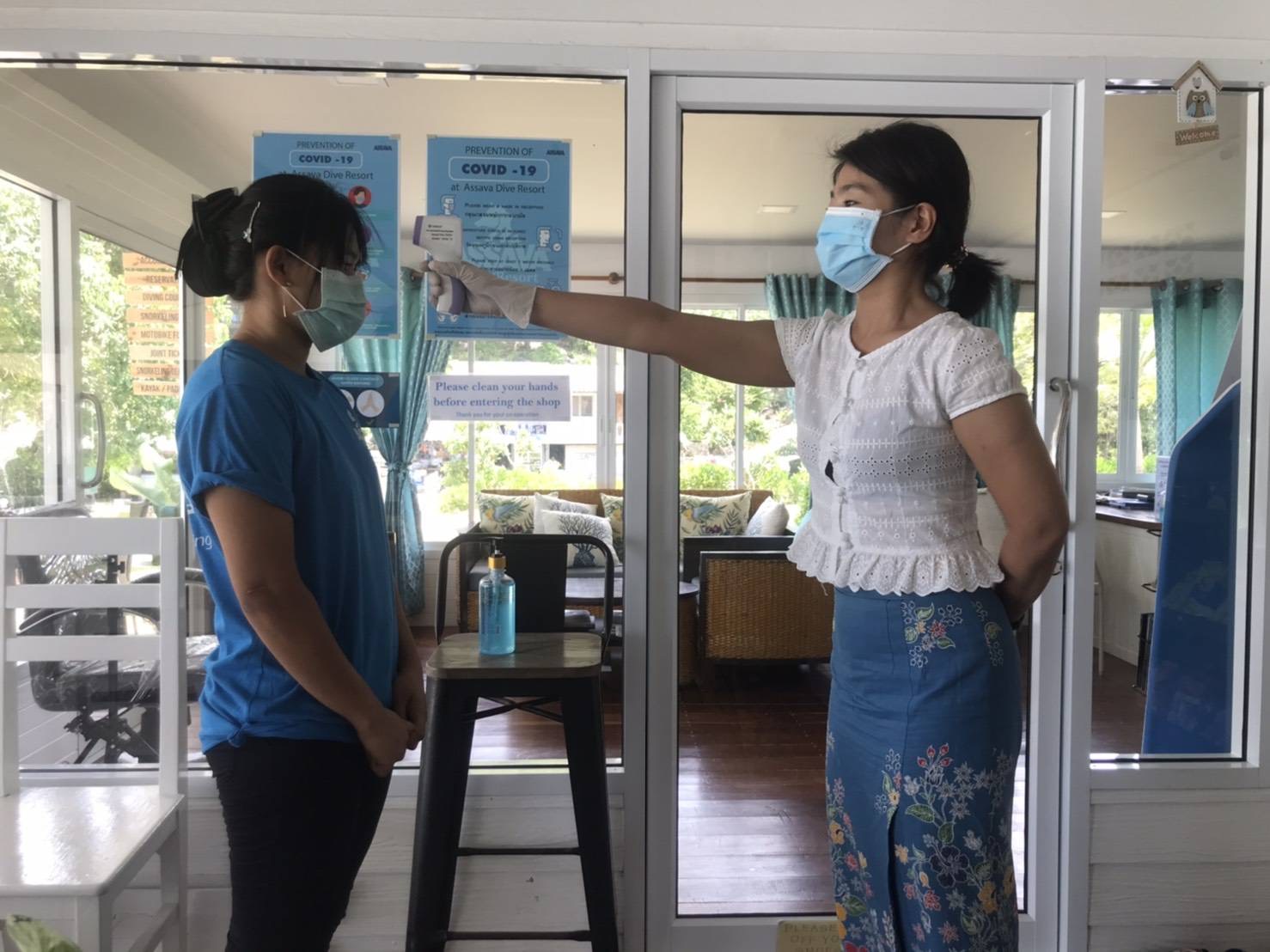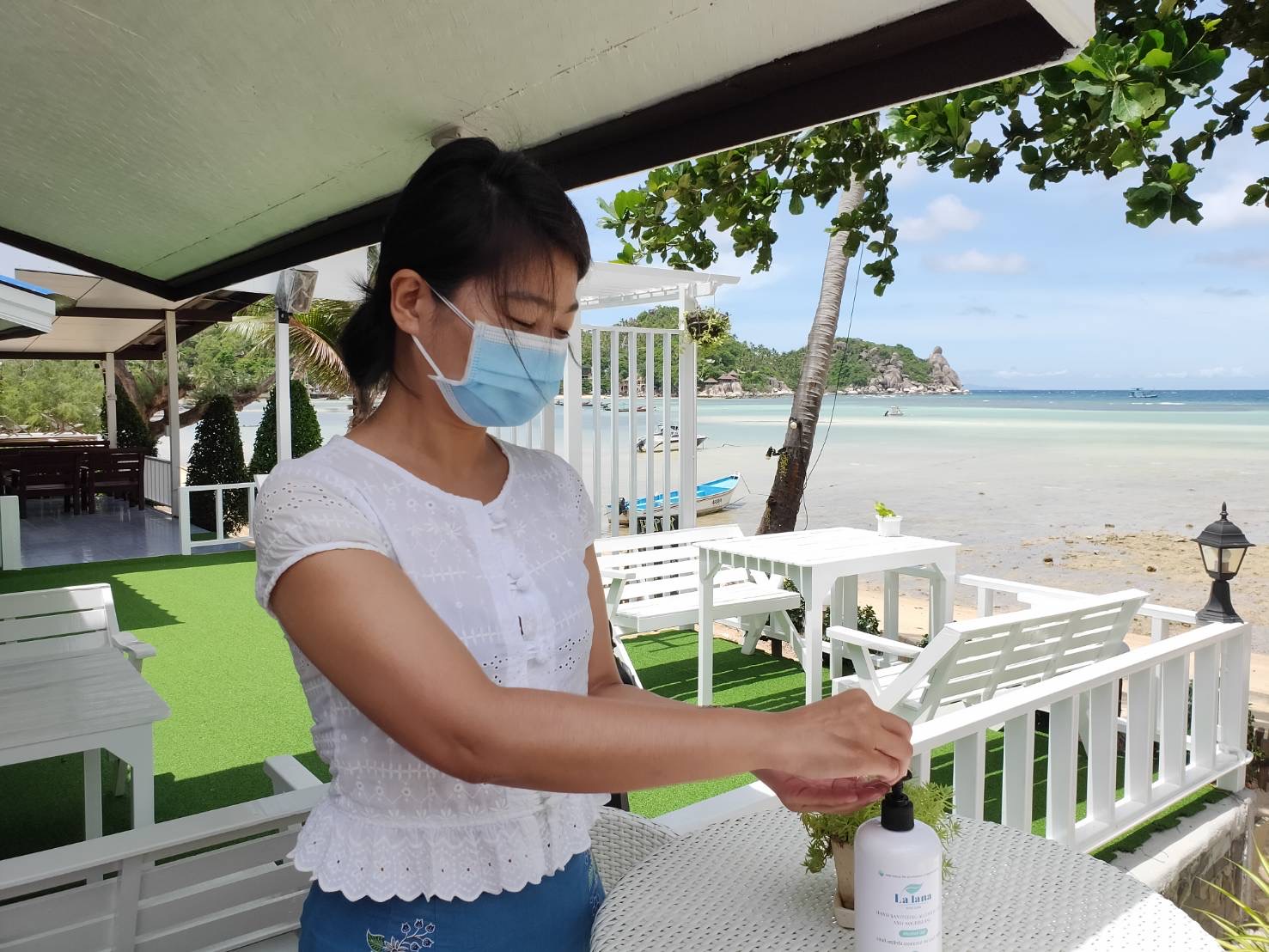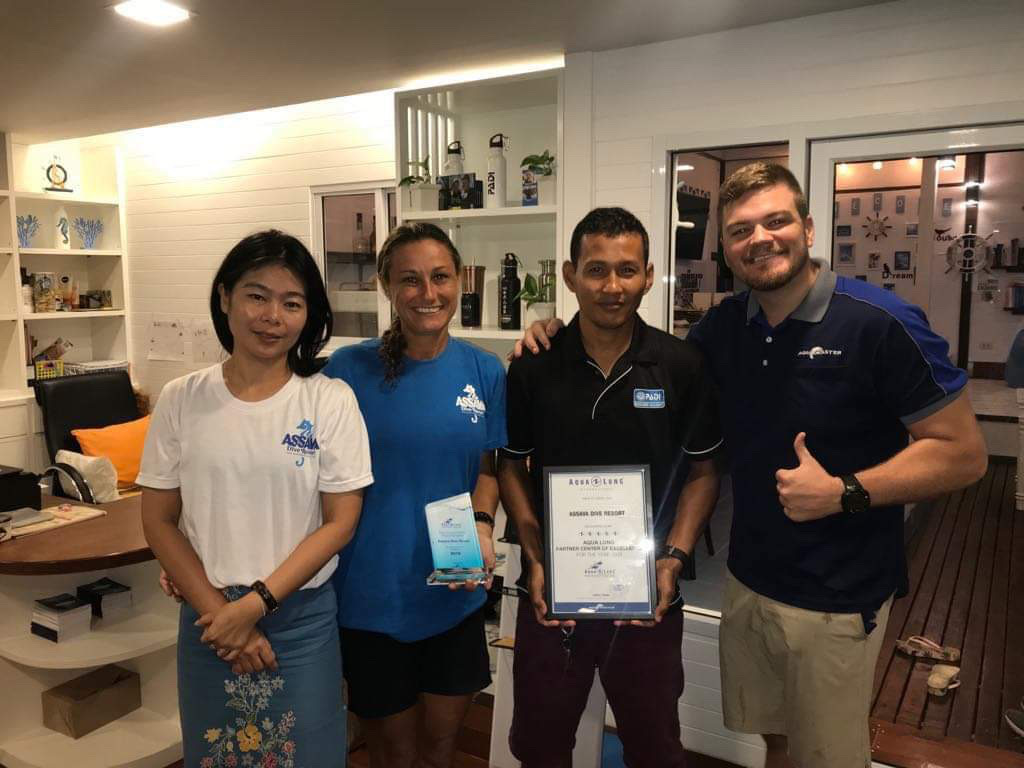Assava Dive Resort - adapting to the new "Normal"
Assava Dive Resort adapting to the new “Normal”.
Now we are slowly opening for business at Assava Dive Resort and you may be wondering how we are adapting to the new “normal” here on Koh Tao. What measures are in place to protect our guests and staff during the pandemic? And how can we adapt boats, classrooms, resort rooms and public places to meet safety recommendations? Koh Tao is Covid free with no reported cases, so we want to keep it that way.
Assava Dive Resort covers a vast area which stretches from the white sandy beaches to our mangrove nursery behind the resort. It is easy to spread out and social distance. Our Cove Restaurant and Bar is all open air and spacious too, so you can enjoy being together, separately.
Other than space, we have taken advice not only from PADI, but also other leading agencies, experts in this field, such as DAN (The Diver’s Alert Network), The World Health Organization, and following local Thai laws, as to what we should be doing to protect you during your stay.
Regarding general movement around the resort, hotel, restaurant, and reception, all areas have been cleaned and sterilized with social distancing measures in place. Staff and guests wear masks and will have their temperature taken on arrival. At every corner you will find hand sanitizer for your personal use, and our Cove Restaurant sells hand sanitizer gels and face masks for your personal safety when moving around the Island. Door handles, desk tops, restaurant tables and chairs, payment areas etc. are all disinfected throughout the day.
With regards to our diving activities, we have added a few more measures on top of our already strict disinfecting regime. Firstly, all divers have their own personal mouthpiece on their regulator. This is removed after every day’s diving for you to take away, and the regulator is disinfected according to guidelines. The equipment rinse tanks are changed more often with extra added disinfectant to sterilize your dive gear. It is then thoroughly rinsed and hung with space in between to dry in our large drying area.
Classes are held in open air classrooms, some of which are next to the beautiful white sandy beach. Reduced ratio classes make social distancing easier, plus give divers the added benefit of more personal tuition. At the moment we are teaching at a ratio of 2 divers to 1 Instructor. This allows everyone, including the Instructor, more time to enjoy courses.
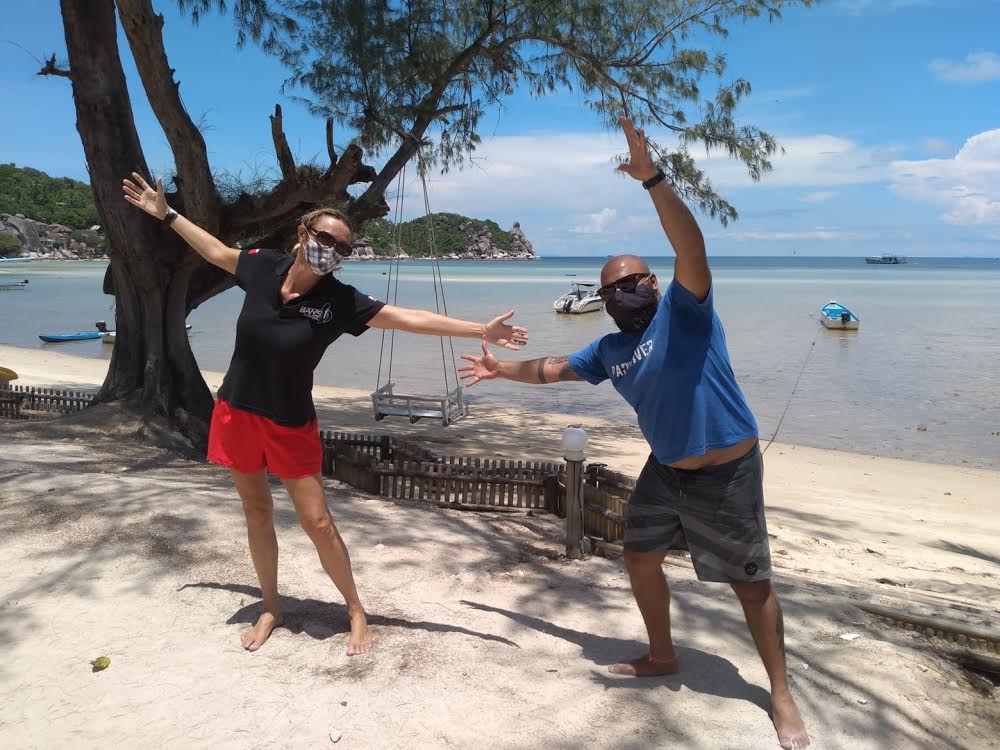
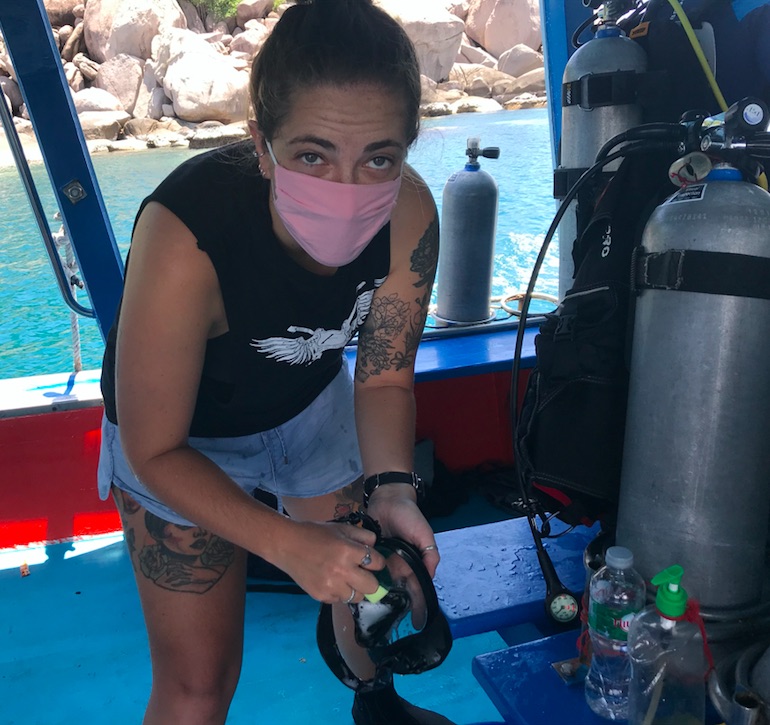
The Assava Dive Boat has a top and bottom deck providing plenty of room onboard to relax while staying a couple of metres away from each other. During surface intervals we wear face masks and have hand sanitizer on board. Instead of using spit to defog masks, we supply on eco friendly soap for all divers to use.
PADI have issued this “8 simple rules….” poster which we have posted on our boats and around the dive centre for our divers’ information. There are some useful tips for divers to stay safe while enjoying our beautiful coral reefs around Koh Tao.
There is no need to social distance underwater. We always dive close to our buddy and dive instructor for safety and enjoyment. However, once positively buoyant on the surface, it’s masks on and regs in until we are on the boat, then swapping to our other masks on the boat.
Many PADI diving courses involve skills which make social distancing difficult. PADI have issued new guidelines to help adapt skills during this time to avoid close contact with fellow students. Assava Dive Resort has implemented these adaptations whilst managing to follow all course standards.
When you are ready and able to return to Koh Tao, either for diving or simply to relax in paradise, rest assured that your health and well being are our priority. We look forward to welcoming you back soon!
Congrats Oliver on becoming a PADI Divemaster !!!
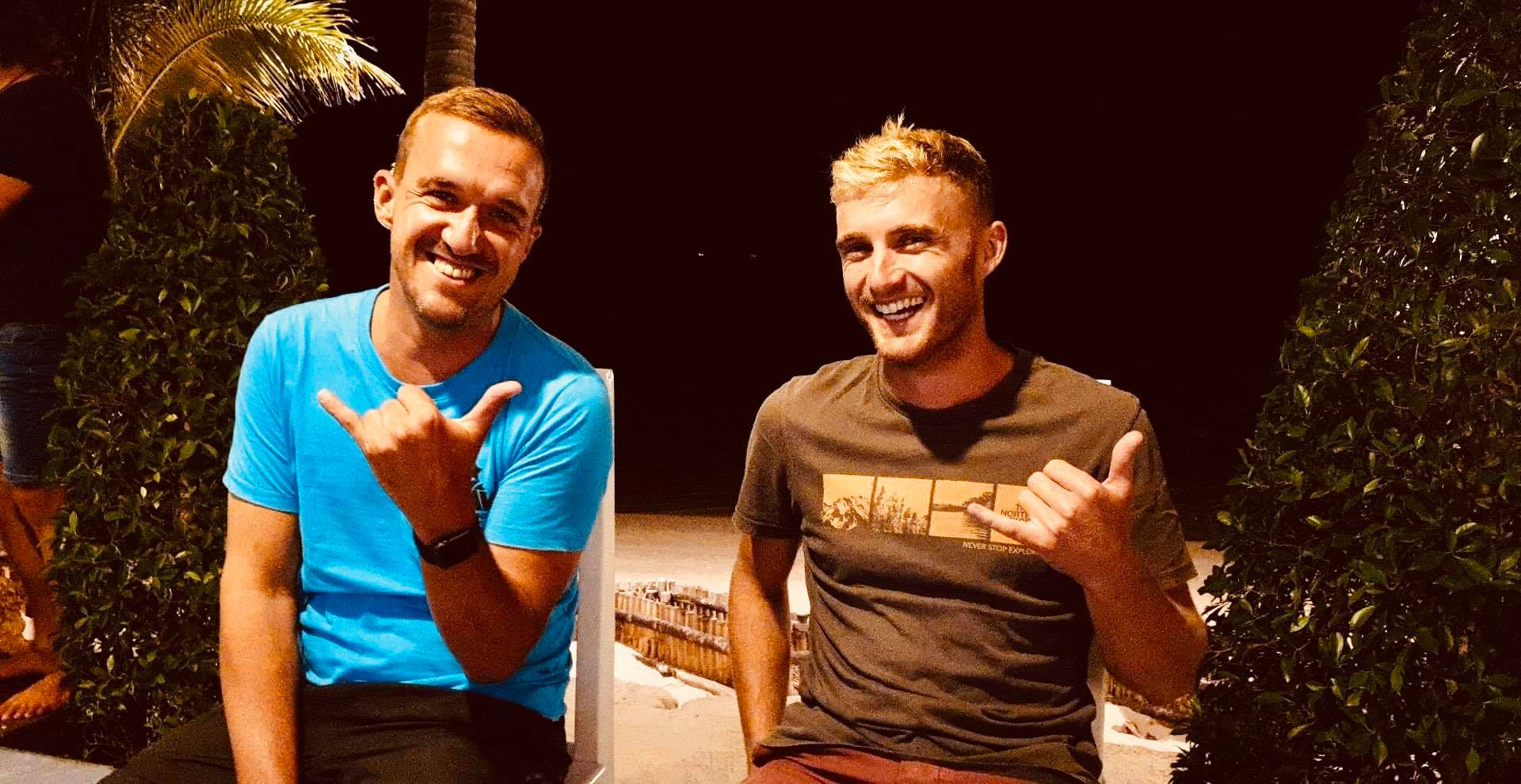
"Oliver Keime and Damian Cook - Celebration of PADI Divemaster Certification!"
Big Congratulations to Oliver Keime on completing his PADI Divemaster Program!
He started his journey by doing the PADI Rescue Diver Course with instructor Kelley Houghton, and decided to continue on to become a PADI Divemaster with her as his mentor. Over several weeks of assisting a variety of courses, participating in many eco projects and learning the role of a PADI Divemaster, we are happy to welcome Oliver into the PADI pro community and look forward to having him on his PADI Instructor Development Course in the coming months. Great Job Olli!!!
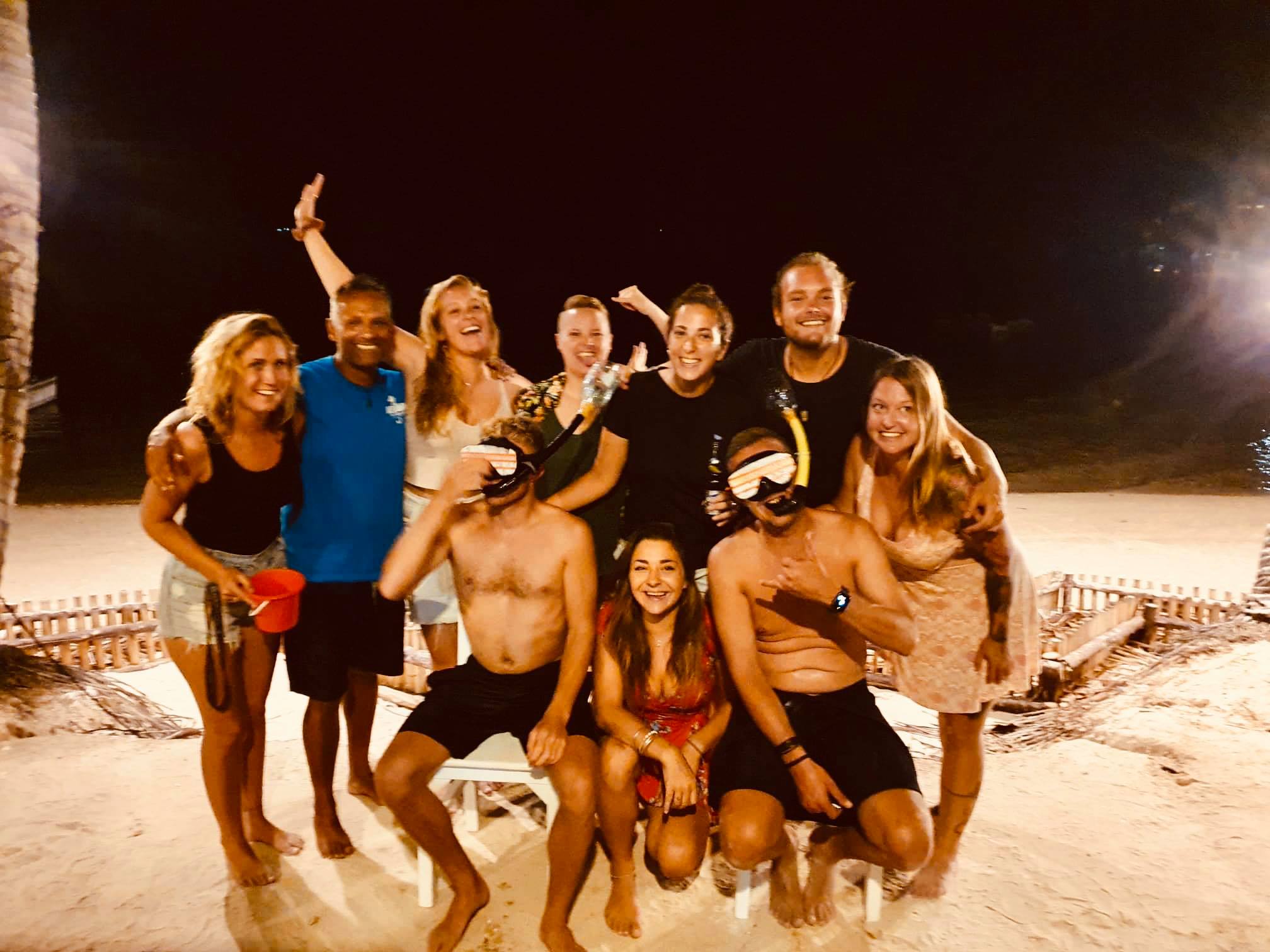
Colin takes on the PADI MSDT and Internship Program
Wonder what happens to our PADI Instructor Development Candidates once they have passed their Instructor Exam? There are several options but the majority of our new instructors progress on to taking the PADI Master Scuba Diver Training and Internship Program.
Colin Adams has been interning with Neil Giblin's through our schools Assava Dive Resort and Ban's Diving Resort.
The opportunity to gain experience in small/medium and large dive operations. During this program he learns course scheduling, lesson planning and skill progression for student divers. Along with gaining the credits to achieve his PADI MSDT rating.
The newly certified divers with Colin and Neil in these photos had a blast during their training!
A few quotes from Trip Advisor:
"we were all German speaking but did the course in English..our trainers were absolutely fantastic with their unique sense of humour, passion for diving and seriousness they made these 3-5 days a highlight of our holiday"
"Diving for the first time can be something quite emotional, but the staff Colin and Neil, reassured me. I also recommend taking the course in English, as a non-native learning the terms in English will prepare me for international use"
A wonderful achievement for these new PADI open water divers and great instruction provided by Colin Adams and Neil Giblin.
Happy World Wildlife Day!
Whale sharks
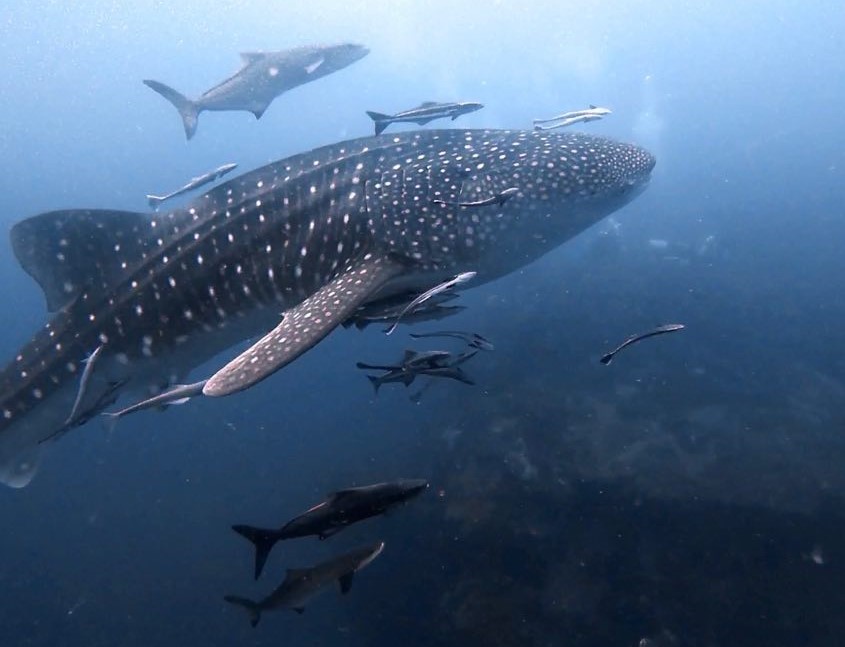
The whale shark is a shark species classified as Endangered on the IUCN Red List. It is the largest of all fish species in the world and can measure up to 19,6 meters. Whale sharks are estimated to live up to 130 years, which means the reach sexual maturity later in life when they are around 25-30 years old. Very little is known about their mating and is extremely rare to see but was recorded for the first-time last year in June outside of Ningaloo Reef, Australia. Females give birth to live young where the eggs hatch inside of the female before birth (ovoviviparous). Just like within other shark species, the pups don’t stay with their mother after birth. However, baby whale sharks are a mystery. As mentioned before, scientists still know very little about how whale sharks reproduce, where they mate, and where they give birth.
Here on Koh Tao divers are sometimes lucky to spot a whale shark, although locals do not all agree on when the best time of the year to see them are. Some believe it’s in February, others in April or October. What most people agree on though is that many of the sightings around Koh Tao are juvenile/younger adult whale sharks, meaning they are rarely over 6 meters long. Still, seeing one of these gentle giants during a dive makes you feel like a tiny individual… Here on Koh Tao, and worldwide, photo identification is used as a research tool to estimate population sizes and to giving information about moving/migration patterns, since each whale shark has individual patterns. This means that the general citizen can contribute to science, by sharing their photos of whale sharks to research groups. Here on Koh Tao, that research group is called Koh Tao Whale Sharks.
The main threats to the shark worldwide are human intrusion and disturbances (recreational activities like snorkelling) and biological resource use like targeted fishing and harvesting of aquatic resources. According to the Department of Marine and Costal Resources, Thailand have around 100 whale sharks roaming in their waters. The Indo-Pacific population have an estimated decline of around 50 % over the last three generation (75 years). Studies show that the annual catch rate from commercial Whale Shark fisheries in Taiwan have had a significant decrease (of around 58 %) between 1997 and 2001. Also, a decline in mean size and length was noted in Chinese waters, where mean size before 2004 was 8.27 m compared to 6.3 m between 2008-2011.
Provisioning (feeding) whale sharks is a fairly common method in some areas in the world to attract tourist by keeping the sharks in the same area all year-round. Whale sharks in Oslob, Philippines are fed >300 kg of uyap (sergestid shrimp) daily (6AM to 12PM, year-round). In the wild, whale sharks do not solely eat shrimp but thrive on a varied diet including other zooplankton, fish eggs, crab eggs, small fish and krill.
One of the main problems with the provisioning industry around whale sharks it that it effects the whale shark’s natural behaviour by interrupting migration patterns that is vital for the breeding of the shark. Studies also show that provisioning is affecting the sharks in a visual and physical way, by changing the shape of their head. This is since they change the position they are feeding, being more vertical than horizontal (since the provisioning comes from boats and are mainly on the surface). Also, studies in Oslob, Philippines show that about 95 % of all whale sharks seen in the area have scars on their body, believed to occur due to boat propellers.
Worldwide conservation efforts include keeping key feeding locations and migration corridors protected. Site protection is necessary in some areas where high densities of whale sharks are present, as anthropogenic pressures on these sites could have disproportionate impact on subpopulation declines. Where whale sharks are routinely feeding on the surface, areas should be managed to reduce vessel strikes in nearby shipping lanes. Mediterranean and Thai waters are where the shark population has declined at the highest rate, IUCN noted in its recent report. A way to stop the decline, Thailand now have the highest legal protection (since May 2019) of the whale shark species.
Aqua Master Partnership Appreciation Award
Assava Dive Resort was recently presented the Aqua Master Partnership appreciation certification by Michael Chambers, aka –Tex, from our local Aqua Master Koh Tao distributor.
Aqua Master is recognized as the leader in high quality diving, snorkeling and swimming equipment. Since 1997, Aqua Master has been the Aqua Lung distributor for a wide range of products to cover all diving, snorkeling and swimming needs within Thailand.
Aqua Lung is the name that first introduced the world to Scuba diving more than 60 years ago when Jacques-Yves Cousteau and Emile Gagnan developed the first “Aqua-Lung”. The excitement and adventurous spirit of that first dive continues today and is relected in Aqua Lung’s dedication to quality and innovation.
Through Assava Dive Resort and The Scuba Store located on Koh Tao, we can provide you with a variety of quality dive equipment. As you start to learn to scuba dive, taking your PADI Dive course programs, you may want to invest in your own dive gear.
Check out this link for promotions and equipment selections along with Aqua Lung Technician courses.
https://www.facebook.com/AquamasterKT/
The Oceans Ballerina - The Lionfish
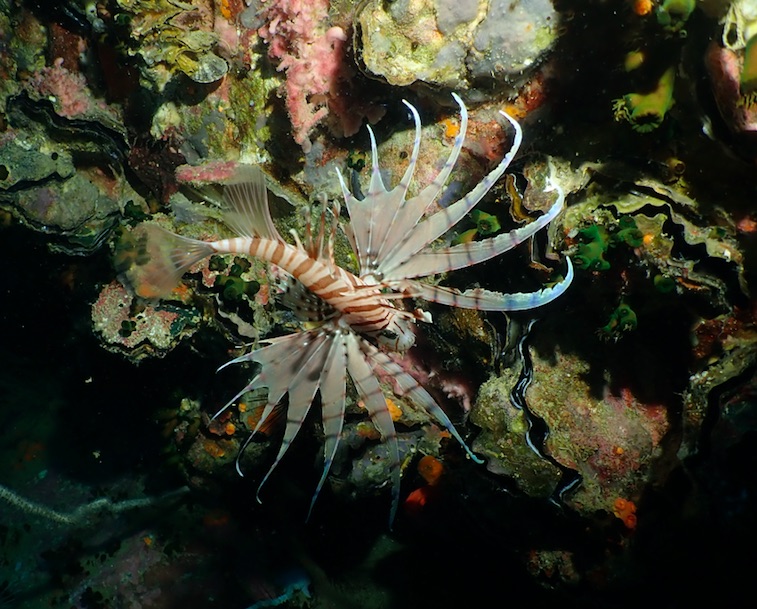
Whilst visiting Koh Tao, you may want to explore our gorgeous underwater rock formations at Chumphon Pinnacles. At varying depths you will see the underwater species “The Lionfish” also knows as the turkeyfish, tigerfish, dragonfish, scorpionfish, and butterfly cod. Mostly found in warm waters in the western and central Pacific oceans, the Lionfish is a predatory fish hunting on smaller fish with its venomous spines.
Although beautiful to look at and wonderful for underwater photos, they can cause direct or indirect damage to coral reefs with their elevated reproduction, all year round spawning and their feeding habits due to the lack of their predators. The Red Lionfish (Pterois volitans) has distinctive stripes (bands) covering its body, alternating white and dark (dark red to brown or black). It has fleshy tentacles above its eyes ad below its mouth.
The Pterois volitans has many sharp spines on its dorsal (back) anal and pelvic (lower sides) fins. Venom glands are located along grooves of each spine. If a spine punctures a victim, the venom enters the wound causing intense pain and swelling. To treat this we apply hot water to the area and seek medical assistance.
Come join us and visit the Koh Tao Chumphon Pinnacles to have the opportunity to view these beautiful dancing creatures.
Next Step - PADI Divemaster!!!
It sometimes feels like you're not sure what to do next - possibly figuring out your next goal in life! This is a natural process especially when you have just completed your school/university and wondering what is to follow... If you are uncertain about your the next step, then you may want to consider becoming a PADI Professional - and the first step is the PADI Divemaster Course.

So where do you start? Firstly you will need to have the basic diving skills beginning with the PADI Open water , Advanced , EFR and Rescue Diver certifications. Once you have these then it's an easy start...
The PADI Divemaster Course duration is around 4 weeks, but through Assava Dive Resort we offer the Divemaster Internship whereby you have the opportunity to learn and absorb all the information for an even longer period of time. Our divemaster candidates tend to stay from 4 weeks to 3 months on the program, learning to assist and supervise on real life dive courses to further develop their personal skills and knowledge on how to be a PADI Professional. We offer a flexible program to suit your schedule whilst on Koh Tao and on your travels through South East Asia.
The program includes assisting on several courses from the PADI open water course to the Rescue Course, learning how to supervise and schedule courses with an instructor. You will also learn the skills you will need once you become a Divemaster through the workshops - including Boat Master duties, skin diver and snorkelling programs, skill circuits, rescue assessments, scuba review workshops, discover scuba diving workshops and more. You will need to show your watership skills - your personal abilities with swimming and self rescue techniques. Along with all the practical workshops you will also have lectures on diving physics, physiology, dive skills & environment, decompression theory and use of the recreational dive planner and dive equipment. On completion you will need to sit two final exams as an assessment of your knowledge of these topics.

Our current Divemaster Candidates have also become involved in the Koh Tao ecological programs - the Marine Debri underwater clean-ups and landclean ups especially at our "Project Aware - Adopt the Reef sites". We offer several specialty programs both Eco - AWARE Marine Debri, AWARE Shark Conservation and Project Aware - Coral Reef Conservation specialties and Non-Eco Specialty programs to further develop your Divemaster Skills.
During our PADI Divemaster Program we also offer our Divemaster Candidates the opportunity to gain experience in several other adventure dives and specialties including Wreck Diving, Search and Recovery, Night Diving, Deep Diving and more....Some candidates choose to apply for their PADI Master Scuba Diver rating alongside their Divemaster Professional Level.
Feel free to contact us at This email address is being protected from spambots. You need JavaScript enabled to view it. for further information about our Professional Programs.
Become a PADI Master Scuba Diver Trainer (MSDT)
Congrats to Kelly-Ann Nickel on her recent achievement as PADI Master Scuba Diver!
Kelly completed her training with a flexible schedule whilst maintaining her employment as a PADI freelance instructor. On the odd days availalbe and where possible with her PADI Course Director Natalie Hunt, Kelly was able to achieve her Specialty Instructor ratings for : Enriched Air Nitrox, Self- Reliant, Deep Diver, Wreck Diver, AWARE Marine Debri and AWARE Shark Conservation.
As Kelly is a Marine Biologist, her specialty instructor ratings for the Eco programs including Project Aware, Coral Reef Conservation and the Marine Debri and Shark Awareness will compliment her teaching these programs to her student divers taking the PADI Open water course or PADI Advanced Course, introducing them to how to preserve our oceans and marine ecosystems.
With our recent visit from Jack Fishman from Project Aware - Kelly further broadened her knowledge on the Marine Debri Awareness program after conducting the clean up underwater dive at Lighthouse Bay. Data from this dive was then added to the Assava Dive Resort - My Ocean Page. www.projectaware.org
Apart from participating in the ECO programs, Kelly developed her personal skills with the Self-Reliant course that was conducted in 2 days. Here you learn how to dive using a redundant air source. Along with having the independent skills of diving solo, she also took on the Wreck Specialty - to have the opportunity to penetrate and explore inside the wrecks that we have on Koh Tao - especially the HTMS Sattakut Wreck.
If interested in becoming a PADI Professional please contact us at : This email address is being protected from spambots. You need JavaScript enabled to view it.
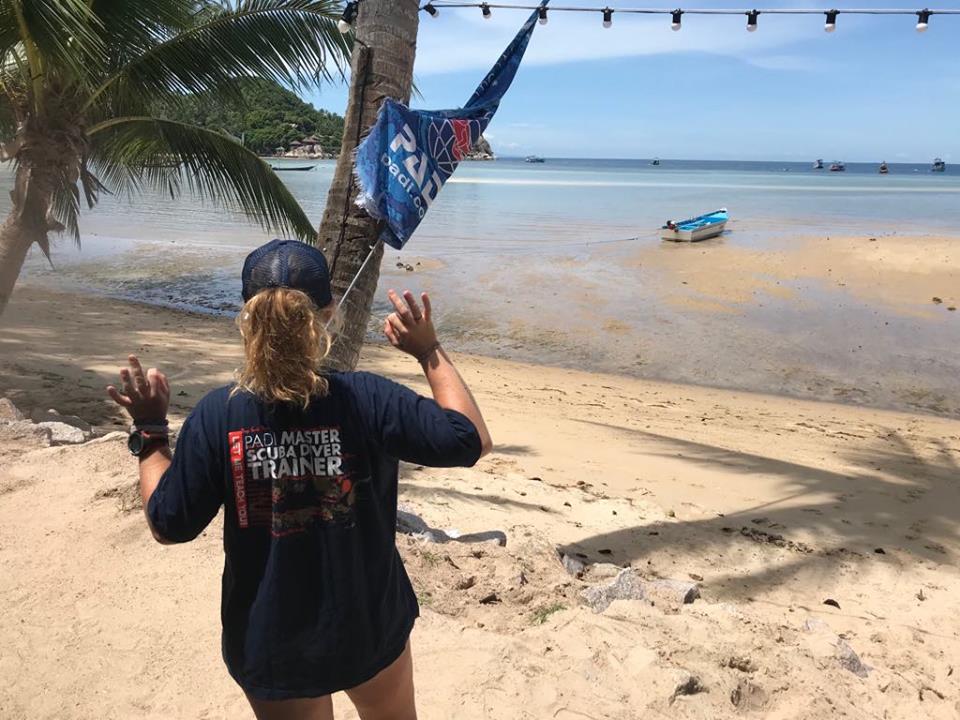
The Inner workings of different Dive Shops!
The divemaster exchange, a chance for a group of Divemaster Candidates to experience the inner workings of another dive shop, but in reality it was so much more!
Having spent the day two months at Sail Rock Divers on Koh Phangnan, this was a chance to experience something different! On arrival, Kelly-Ann Nickel, the instructor who would be looking after us, gave us a quick orientation of where everything was, pointing out the new renovations being completed to mark Assava Dive Resort's 20th anniversary.
Next, we met Jack, the Dutch instructor whose fun divers we'd be helping out with. He showed us how they organised their equipment, made the crew lists and explained all the logistics of taking a group of people out on a dive. As per expectation, the main structure of it all was the same with its slight uniqueness - "same same, but different".
Following was the part we'd been looking forward to, the diving! With Koh Tao being famous for its diving, boasting 74 dive shops on an island a third of the size of Koh Phangan, we knew we were in for a treat! First was Chumphon Pinnacle. An underwater pinnacle filled with diversity of the Thai Gulf: from the small lionfish to sting-rays and huge schools of fusiliers to reef sharks. This was an amazing introduction to diving on Koh Tao. Crystal clear water and abundance of underwater life.
We then visited the HTMS Sattakut Wreck - A ship from WW2 donated to Koh Tao that was sunk to offer a diversity of dive sites for Koh Tao in 2011. This wreck has now become a habitat to many fish. Being our first wreck dive, we were very much excited. So much so that one of us decided to stay an extra few days to pursue the wreck specialty. This was also a chance to assist on an advanced open-water course. A big shout out to Elred, whose course we were helping out with, and is currently cycling from Singapore to Hong Kong - #cyclefoodfun.
After the wreck dive, it was our chance to help on an Instructor Development Course (IDC). This was an opportunity to see what happens on an IDC should we wish to continue our diving education. Natalie Hunt, the PADI Course Director at Assava Dive Resort, would assign problems that the IDC candidates would have to spot and help us correct. Best of luck to you guys at the IE! Within the space of a few hours we'd already made three dives but there was still one more left today - a night dive. Once again we were helping out with Elred's night dive adventure dive.
As the sunset in the far distance, Kelly made a dive briefing and in darkness we made our descent into the water. This was the last dive for Elred before he would set off on his travels. Congrats on earning your advanced open-water license! The morning after, slightly tired from the jam packed day and night of libations, we had two more dives to enjoy Koh Tao's amazing and plentiful dive sites.
First we visited White rock once again but this time guided by sunlight. I was rather shocked to discover how much I missed the night before. This time it was my chance to have a fun dive with Ellie, a divemaster candidate at Assava. Then we went to dive at a site called Twins. A curious site with some man made structures mainly used for peak performance buoyancy lessons. Attractions like the "rocktapus" and hoops similar to that from a Harry Potter - quidditch game. It almost had a rather eerie feel of a disused amusement park. But alas it gave us a chance to test the expert watermanship skills required from a divemaster.
Then there was one last surprise for me! A taste of Burmese food! Not something that I expected I'd try on Koh Tao but was I in for a treat. Kelly and I decided to grab a Burmese curry just before I left. Blimey it was spicy! One of those dishes that tries to scare you off with the spices but gets you hooked regardless of the burning tongue. It was a brilliant way to finish off my exchange.
Once again thank you to everyone at Assava Dive Resort for giving us an amazing time and many thanks to David Arnold, our PADI Course Director at Sail Rock Divers who helped organise this divemaster exchange. Special shout out to PADI Course Director Natalie Hunt and instructor Kelly Ann Nickel for organising the best two days!
Cheers from Ollie and Jaeho!!! (Divemaster Candidates from Sail Rock Divers)

Dive Master Exchange With Assava Dive Resort and Sail Rock Divers.
Dive Master Exchange With Assava Dive Resort and Sail Rock Divers.
Myself – Kelley and one other dive master candidate Marko, were the lucky ones selected to go from Assava Dive Resort on Koh Tao to Sail Rock Divers on Koh Phangan as part of an exchange program between our two PADI 5 Star IDC Dive Centres. Two Divemaster Candidates from each school where chosen to experience how another dive shop is run and gain a different perception of how dive operations run at a new location and dive sites.
I can't say enough good things about the experience it was truly the type of trip that money just can't buy. We arrived first thing in the morning and were picked up by Peter, one of their senor instructors, and shown around the shop. It was really interesting to see how another dive shop was set up and works. After a small tour of the area and a little breakfast at a local restaurant we went for an afternoon dive at one of the local dive sites called Mae Haad.
We did a shore dive, was a fun experience since as this is not something that is common on Koh Tao. In the briefing before the dive we were given some basic tips on navigating the site and at some point during the dive we were both asked to lead the dive for a bit. It was a great experience for navigating a dive site that was not familiar to us.
When we got back to the shop we were shown to our bungalows that we would stay in for the night. Both were just steps from the dive shop itself and very comfortable and spacious having separate bedrooms, kitchens and bathrooms and even air-conditioning! After getting settled in to our rooms we were given scooters to borrow so that we could go explore the island of Koh Phangan. We drove for maybe 45 minutes and eventually ended up having lunch on a beautiful beach on the other side of the island. Having stayed on Koh Tao for some time, it was nice to be able to drive around for so long and see what a much larger island has to offer.
On our return to the shop the Sail Rock staff put together a BBQ and social event to welcome us to the shop. Fantastic food and a great way to meet everyone and enjoy the little bar they have on site. Such amazing hospitality and everyone was so great and welcoming, it was a real joy.
The next morning we headed out early to the dive boat - for Sail Rock, possibly one of the best dive sites this area has to offer. On board we had breakfast and lunch provided. When we got to Sail Rock, we had the opportunity to help with the dive site setup by securing buoys in a way that they wouldn't damage the reef and would allow them to do all the training skills that require the use of a line. After we had a great tour of the Sail Rock and all it has to offer. On our second dive we were lead by one of the dive master candidates from Sail Rock Divers for about half the dive then I had the chance to lead that was really fun and a great experience. We ended the dive with three friendly Whale Sharks and were also greeted by an amazing pod of Pilot Whales. Definitely more than we could have ever asked for!
On the way back to the shop everyone's spirits were high from the truly spectacular dives but I couldn't help but feel a little sad that we would be leaving in a few hours. After meeting everyone and having such an amazing time, I would have loved to be able to stay for a few more days and continue to learn from the team there but all good things must come to an end. One thing is for sure, I will definitely be going back to visit Sail Rock Divers to do a few more dives with them and say hello!

